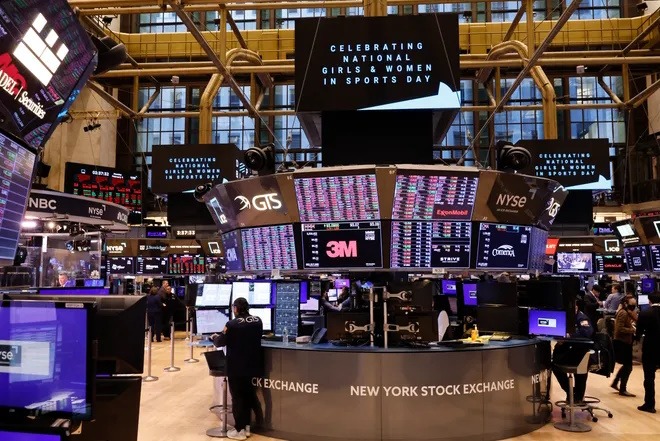
Dow futures declined on Friday following the announcement by President Donald Trump regarding additional tariffs on Canadian imports. This development has heightened concerns about potential increases in duties on other trading partners, thereby impacting global trade dynamics. Nvidia’s market capitalization broke through the $4 trillion level, while Bitcoin also registered record highs.
U.S. President Donald Trump maintained his critique of the existing global trade framework late Thursday, announcing that the U.S. would implement a 35% tariff on Canadian imports next month and intended to apply blanket tariffs of 15% or 20% on the majority of other trading partners. In a letter disseminated via his social media platform, Trump informed Canadian Prime Minister Mark Carney that the new rate would take effect on August 1, with the stipulation that it would increase should Canada choose to retaliate. The 35% tariff represents an escalation from the existing 25% rate previously established by Trump for Canada. However, it was anticipated that the exclusion for goods encompassed by the United States-Mexico-Canada Agreement would remain intact, while the 10% tariffs on energy and fertilizer were expected to remain unchanged. In recent developments, Trump has expanded his trade war by imposing new tariffs on several nations, including allies such as Japan and South Korea, as well as instituting a 50% tariff on copper.
S&P 500 futures were down by 26 points, reflecting a decrease of 0.4%. Meanwhile, Nasdaq 100 futures experienced a decline of 42 points, or 0.2%, and Dow futures fell by 200 points, corresponding to a 0.5% drop. The primary indices on Wall Street concluded the trading session on a positive note Thursday, with the S&P 500 and Nasdaq Composite achieving new closing highs. However, market sentiment experienced a significant shift following President Trump’s announcement of a 35% tariff on all Canadian goods effective August 1. The major averages are positioned to conclude the week with minimal variation, as the Dow Jones Industrial Average remains just below the flat line on a weekly scale, while the S&P and Nasdaq exhibit increases of less than 1%. Markets are currently attentive to the possibility of Trump losing patience with the European Union, as EU officials indicate their objective is to secure a deal prior to August 1.
Nvidia concluded trading on Thursday with a market capitalization exceeding $4 trillion for the first time, solidifying the AI chipmaker’s position as the world’s most valuable company. Nvidia concluded the trading session with a market capitalization of $4.004 trillion, marking an increase of 89% from its lows in April. It stands as the first company to close above this threshold, having briefly surpassed it during Wednesday’s session. The accomplishment arises in the context of sustained robust demand for artificial intelligence technologies that underpin Nvidia’s operations. “We reinvented computing for the first time since the 60s, since IBM introduced the modern computer architecture,” Nvidia CEO Jensen Huang stated on MSNBC’s Morning Joe, reflecting on this significant milestone. “And over the last 33 years, we’ve been engaged in the transformation of computing.” Over the past five years, it has experienced significant growth.
Bitcoin, the world’s largest cryptocurrency, experienced a significant increase on Friday, reaching a peak of $118,000, driven by strong institutional interest and favorable regulatory measures during President Trump’s administration. Bitcoin experienced a notable increase of 5.6%, reaching $117,670, following a peak of $118,320 earlier in the session. The milestones arrive in the context of increasing interest from institutional investors in incorporating bitcoin into treasury portfolios and ETFs. U.S. spot bitcoin ETFs recorded net inflows of $1.18 billion, indicating a sixth consecutive day of significant gains, as reported by SoSoValue. Total trading volume across the 12 bitcoin ETFs reached $6.3 billion, marking the highest daily level since late May. The administration of President Trump, earlier this year, sanctioned a strategic Bitcoin reserve, fostering a positive regulatory atmosphere. A notable development emerged this week as a prominent Chinese regulator convened a strategic meeting aimed at advising local government officials on the policies surrounding stablecoins and digital currencies. Reports and social media posts indicated this shift in China’s approach to digital currencies.
Oil prices experienced an uptick on Friday, driven by heightened expectations surrounding further sanctions on Russia. However, these gains have been moderated by concerns regarding tariffs and a rise in OPEC+ production levels. Brent futures increased by 0.4% to $68.94 per barrel, while U.S. West Texas Intermediate crude futures advanced by 0.6% to $66.96 per barrel. Both contracts experienced a decline exceeding 2% on Thursday, as investors expressed concerns regarding the implications of Trump’s shifting tariff policy on global economic growth and oil demand. Nevertheless, sentiment has improved following Trump’s expressed frustration with Russian President Vladimir Putin regarding the stagnation in peace efforts with Ukraine, which heightens the likelihood of additional sanctions on the significant oil producer.
